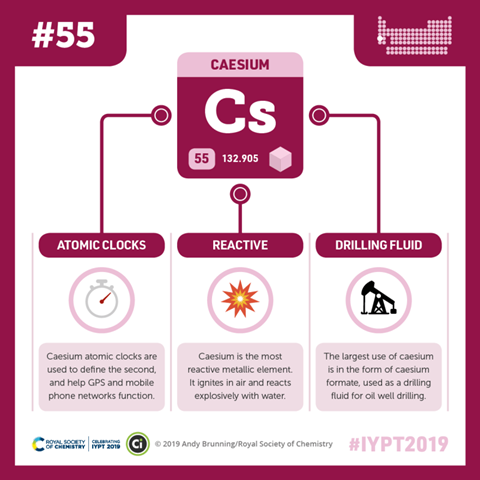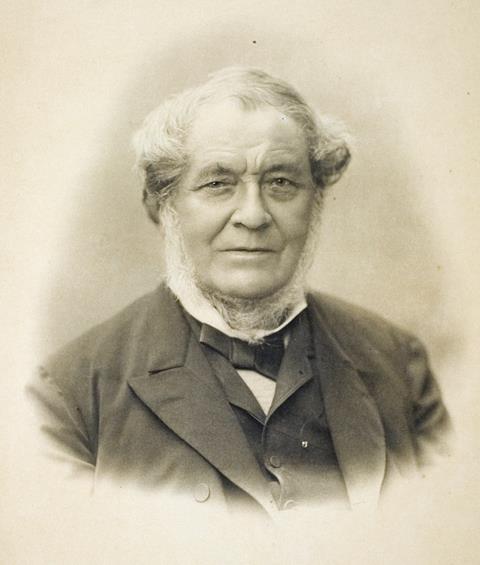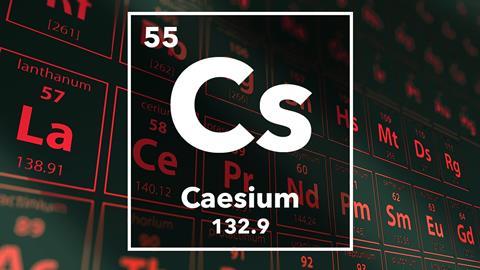Meera Senthilingam
This week, love at first sight. Peter Wothers.
Peter Wothers
I've been asked on a number of occasions what my favourite element is. I used to think either oxygen or hydrogen – both so much fun – but that was until my sample of caesium arrived, when it was love at first sight. Now many people think it's slightly odd having a favourite element, but when they too see my caesium, they understand why it's so special. Who wouldn't be attracted to this beautiful element?
For starters, there are only three metallic elements that are not silver-coloured. Two are well-known and fairly obvious – gold and copper. The third most people would never guess, it's caesium. Apparently, the beautiful gold diminishes if the sample is extremely pure since tiny traces of captured oxygen give it the colour. This is a little disappointing – its colour is quite stunning and I would be sad if it really did disappear when purified.

The next exciting thing about caesium is that my love is not unrequited, it responds to my touch. Strictly speaking, it's the warmth from the hand that melts it, given that its melting point is only 28.4°C. So just holding its container converts the crystalline solid into liquid gold. Liquid metals are always fascinating – everyone loves mercury; just imagine playing with liquid gold!
But here's the snag that adds to my fascination with this metal - it has a rather fiery temper. In fact, you can't actually touch the metal itself since it spontaneously bursts into flames in the presence of air and reacts explosively with water. Awkward indeed. My caesium is sealed inside a glass tube under an atmosphere of the chemically inert gas argon. So to play with it, you have to hold the glass tube, knowing that if you accidentally crushed it, or dropped it, all hell would break loose.

Caesium gets its name from the Greek for heavenly blue. Not for its eyes (it's only an element!) but less romantically for the appearance of its emission spectrum in the spectroscope. Caesium was discovered in 1860 by Robert Bunsen (he of the burner fame) and physicist Gustav Kirchhoff. The previous year they had invented an instrument known as a spectroscope to help in chemical analysis. When atoms are energetically excited, for instance when a compound is introduced into a flame, electrons can temporarily be promoted to higher energy levels. When they return to their lower energy states, energy is released in the form of light. The spectroscope splits up the light with a prism and reveals a spectrum consisting of series of sharp coloured lines. Each element has its own unique spectrum of lines, like a rainbow barcode. When examining the spectrum of the residue from some spa mineral water, Bunsen and Kirchhoff found a series of lines that did not correspond to any known element. They named the new element caesium because of the distinct blue lines in the spectrum.

It is another electronic transition in caesium that gives us the most accurate clocks on earth. So called caesium atomic clocks are accurate to one second in more than a million years and are used when precision timing is crucial, for instance in tracking the space shuttle.
It is its willingness to lose an electron completely and form a positively charge ion that makes caesium the most reactive metal in the periodic table, and yes I am including its relative francium! All the alkali metals are reactive because they have one outermost electron which is easily removed but on moving down the group, the atoms get larger and larger and this outermost electron gets on average further and further away from the positively charged nucleus. What's more, on moving across the periodic table, from group one with lithium, sodium, potassium etc to group two with beryllium, magnesium, calcium and so on, it becomes increasingly harder to remove the outermost electrons. This means the element for which it is easiest to remove an electron and form a cation, is in the bottom left-hand corner of the periodic table, where caesium is found.
One pseudo-science programme on TV showed the reaction between water and the different group one alkali metals, namely lithium, sodium, potassium, rubidium and caesium. At least that's what they said. Actually, they faked the reaction of rubidium and caesium with water since they thought they were not spectacular enough for TV. They also said that the element beneath caesium in the periodic table, francium, would be even more reactive. They were wrong. It turns out for really heavy elements, the electrons begin to get slightly harder to remove than expected.
In order to understand why, you would need to take into account Einstein's relativistic effects. Theory predicts that the atoms begin to get slightly smaller and that it is actually harder to remove the outermost electron from francium than it is for caesium. Remarkably, this experiment has been carried out and the prediction has been confirmed. This means that despite what you may hear, or might have expected, caesium is the most reactive metal. This is great since francium can only be made in miniscule proportions and then only lasts for a few minutes so you'll never see any. Caesium on the other hand, is readily obtainable, and in its protective environment will last forever. This means we can actually see, hold and play with the most reactive metallic element that nature has given us. It's gorgeous, but watch out, it bites!
Meera Senthilingam
And having seen the melting of this element in action, I must admit it is rather beautiful. That was Cambridge University's Peter Wothers with the chemistry of his favourite element caesium. Is it your favourite yet? Well if not listen next week when we discover an element created by cold fusion.
Eric Scerri
bohrium is also special in another respect, as the first element to be synthesised by a cold – rather than hot – fusion process between two nuclei. The idea is to make two nuclei collide at low excitation energies and consequently to capitalise on the reduced tendency of such combined atoms to disintegrate. The successful cold fusion synthesis of bohrium was first achieved in 1981 in Darmstadt, Germany, by the fusion of bismuth-209 with chromium-24 to form bohrium-262 with a half-life of about 85 milliseconds. Since then many other isotopes of bohrium have been produced, including the longest lived isotope so far bohrium-270, with a half-life of 61 seconds.
Meera Senthilingam
And join UCLA's Eric Scerri for the chemistry created by this fusion in next week's Chemistry in its element. Until then thank you for listening, I'm Meera Senthilingam.













No comments yet